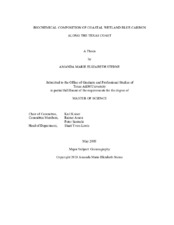| dc.description.abstract | This study represents a detailed analysis of the biochemical composition of organic carbon (OC) preserved in coastal wetland systems. Coastal wetlands are sensitive to anthropogenic disturbances with habitats undergoing development into both urban and farm areas. Additionally, these ecosystems are sensitive to climate change and have been documented to shift with accelerated sea-level rise and changing temperature regimes. The estimated magnitude of organic carbon (OC) stocks contained in the first meter of US coastal wetland soils represents ~10% of the entire OC stock in US soils (4 vs. 52 Pg, respectively). Because this stock extends to several meters below the surface for many coastal wetlands, it becomes paramount to understand the fate of OC under ecosystem shifts, varying natural environmental constraints, and changing land utilization. Here we analyzed stable isotopic data (δ13C), total hydrolysable neutral sugars, amino acids, phenols, and cutin acids at two study sites located on the Texas coastline to investigate the nature of OM stored in two wetland ecosystem types along the Texas coastline, Avicennia germinans (black mangrove) and Spartina alterniflora (cordgrass). Northward expansion of the mangrove ecotone has occurred over the past 100 years with the decreased occurrence of freezing events during winter periods. Due to the recognized efficiency of C burial in these environments we opted to take a closer look at the effects of this shift on sedimentary C dynamics. Results showed sharp declines of neutral sugar yields with depth occurred parallel to increases in lignin degradation ratios indicating substantial decomposition of both the polysaccharide and lignin components of litter detritus.
Neutral sugar compositions allowed reconstruction of past dominant vegetation by utilizing unique hemicellulosic carbohydrate compositions. While overall magnitude of OC in these sediments was almost equal, the chemical composition of buried OC was notably different regardless of supposed lability or recalcitrance of the different biochemical classes. Overall, biomarker data suggest litter chemistry is the primary control of C preservation in these wetland ecosystems | en |


